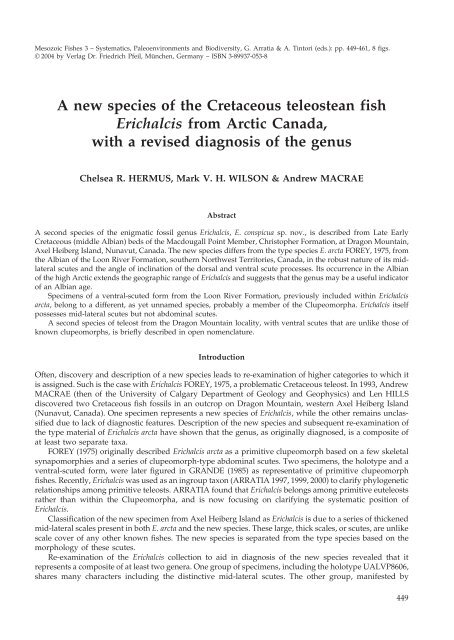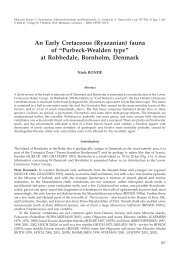A new species of the Cretaceous teleostean fish Erichalcis from ...
A new species of the Cretaceous teleostean fish Erichalcis from ...
A new species of the Cretaceous teleostean fish Erichalcis from ...
You also want an ePaper? Increase the reach of your titles
YUMPU automatically turns print PDFs into web optimized ePapers that Google loves.
Mesozoic Fishes 3 – Systematics, Paleoenvironments and Biodiversity, G. Arratia & A. Tintori (eds.): pp. 449-461, 8 figs.<br />
© 2004 by Verlag Dr. Friedrich Pfeil, München, Germany – ISBN 3-89937-053-8<br />
A <strong>new</strong> <strong>species</strong> <strong>of</strong> <strong>the</strong> <strong>Cretaceous</strong> <strong>teleostean</strong> <strong>fish</strong><br />
<strong>Erichalcis</strong> <strong>from</strong> Arctic Canada,<br />
with a revised diagnosis <strong>of</strong> <strong>the</strong> genus<br />
Chelsea R. HERMUS, Mark V. H. WILSON & Andrew MACRAE<br />
Abstract<br />
A second <strong>species</strong> <strong>of</strong> <strong>the</strong> enigmatic fossil genus <strong>Erichalcis</strong>, E. conspicua sp. nov., is described <strong>from</strong> Late Early<br />
<strong>Cretaceous</strong> (middle Albian) beds <strong>of</strong> <strong>the</strong> Macdougall Point Member, Christopher Formation, at Dragon Mountain,<br />
Axel Heiberg Island, Nunavut, Canada. The <strong>new</strong> <strong>species</strong> differs <strong>from</strong> <strong>the</strong> type <strong>species</strong> E. arcta FOREY, 1975, <strong>from</strong><br />
<strong>the</strong> Albian <strong>of</strong> <strong>the</strong> Loon River Formation, sou<strong>the</strong>rn Northwest Territories, Canada, in <strong>the</strong> robust nature <strong>of</strong> its midlateral<br />
scutes and <strong>the</strong> angle <strong>of</strong> inclination <strong>of</strong> <strong>the</strong> dorsal and ventral scute processes. Its occurrence in <strong>the</strong> Albian<br />
<strong>of</strong> <strong>the</strong> high Arctic extends <strong>the</strong> geographic range <strong>of</strong> <strong>Erichalcis</strong> and suggests that <strong>the</strong> genus may be a useful indicator<br />
<strong>of</strong> an Albian age.<br />
Specimens <strong>of</strong> a ventral-scuted form <strong>from</strong> <strong>the</strong> Loon River Formation, previously included within <strong>Erichalcis</strong><br />
arcta, belong to a different, as yet unnamed <strong>species</strong>, probably a member <strong>of</strong> <strong>the</strong> Clupeomorpha. <strong>Erichalcis</strong> itself<br />
possesses mid-lateral scutes but not abdominal scutes.<br />
A second <strong>species</strong> <strong>of</strong> teleost <strong>from</strong> <strong>the</strong> Dragon Mountain locality, with ventral scutes that are unlike those <strong>of</strong><br />
known clupeomorphs, is briefly described in open nomenclature.<br />
Introduction<br />
Often, discovery and description <strong>of</strong> a <strong>new</strong> <strong>species</strong> leads to re-examination <strong>of</strong> higher categories to which it<br />
is assigned. Such is <strong>the</strong> case with <strong>Erichalcis</strong> FOREY, 1975, a problematic <strong>Cretaceous</strong> teleost. In 1993, Andrew<br />
MACRAE (<strong>the</strong>n <strong>of</strong> <strong>the</strong> University <strong>of</strong> Calgary Department <strong>of</strong> Geology and Geophysics) and Len HILLS<br />
discovered two <strong>Cretaceous</strong> <strong>fish</strong> fossils in an outcrop on Dragon Mountain, western Axel Heiberg Island<br />
(Nunavut, Canada). One specimen represents a <strong>new</strong> <strong>species</strong> <strong>of</strong> <strong>Erichalcis</strong>, while <strong>the</strong> o<strong>the</strong>r remains unclassified<br />
due to lack <strong>of</strong> diagnostic features. Description <strong>of</strong> <strong>the</strong> <strong>new</strong> <strong>species</strong> and subsequent re-examination <strong>of</strong><br />
<strong>the</strong> type material <strong>of</strong> <strong>Erichalcis</strong> arcta have shown that <strong>the</strong> genus, as originally diagnosed, is a composite <strong>of</strong><br />
at least two separate taxa.<br />
FOREY (1975) originally described <strong>Erichalcis</strong> arcta as a primitive clupeomorph based on a few skeletal<br />
synapomorphies and a series <strong>of</strong> clupeomorph-type abdominal scutes. Two specimens, <strong>the</strong> holotype and a<br />
ventral-scuted form, were later figured in GRANDE (1985) as representative <strong>of</strong> primitive clupeomorph<br />
<strong>fish</strong>es. Recently, <strong>Erichalcis</strong> was used as an ingroup taxon (ARRATIA 1997, 1999, 2000) to clarify phylogenetic<br />
relationships among primitive teleosts. ARRATIA found that <strong>Erichalcis</strong> belongs among primitive euteleosts<br />
ra<strong>the</strong>r than within <strong>the</strong> Clupeomorpha, and is now focusing on clarifying <strong>the</strong> systematic position <strong>of</strong><br />
<strong>Erichalcis</strong>.<br />
Classification <strong>of</strong> <strong>the</strong> <strong>new</strong> specimen <strong>from</strong> Axel Heiberg Island as <strong>Erichalcis</strong> is due to a series <strong>of</strong> thickened<br />
mid-lateral scales present in both E. arcta and <strong>the</strong> <strong>new</strong> <strong>species</strong>. These large, thick scales, or scutes, are unlike<br />
scale cover <strong>of</strong> any o<strong>the</strong>r known <strong>fish</strong>es. The <strong>new</strong> <strong>species</strong> is separated <strong>from</strong> <strong>the</strong> type <strong>species</strong> based on <strong>the</strong><br />
morphology <strong>of</strong> <strong>the</strong>se scutes.<br />
Re-examination <strong>of</strong> <strong>the</strong> <strong>Erichalcis</strong> collection to aid in diagnosis <strong>of</strong> <strong>the</strong> <strong>new</strong> <strong>species</strong> revealed that it<br />
represents a composite <strong>of</strong> at least two genera. One group <strong>of</strong> specimens, including <strong>the</strong> holotype UALVP8606,<br />
shares many characters including <strong>the</strong> distinctive mid-lateral scutes. The o<strong>the</strong>r group, manifested by<br />
449
The whole contribution can be<br />
purchased as PDF fi le.<br />
Availability<br />
Generally all our publications are available as PDF fi les;<br />
full publications as a general rule after <strong>the</strong> printed version<br />
is out <strong>of</strong> print. If you have questions concerning particular<br />
contributions please contact us by e-mail:<br />
pdf@pfeil-verlag.de.<br />
The PDF fi les are protected by copyright.<br />
The PDF fi le may be printed for personal use.<br />
The reproduction and dissemination <strong>of</strong> <strong>the</strong> content or<br />
part <strong>of</strong> it is permitted.<br />
It is not allowed to transfer <strong>the</strong> digital personal certifi cate<br />
or <strong>the</strong> password to o<strong>the</strong>r persons.<br />
Prices<br />
Books: Prices are to be found in <strong>the</strong> catalog.<br />
Articles in journals and single contributions or chapters<br />
in books:<br />
10 EURO basic price per order (including <strong>the</strong> fi rst 10<br />
pages),<br />
and<br />
0.50 EURO per page, beginning with <strong>the</strong> 11th page.<br />
Page numbers are found in <strong>the</strong> contents <strong>of</strong> <strong>the</strong> publications.<br />
Orders<br />
Use our order form for PDF fi les or send your order informal<br />
per e-mail (pdf@pfeil-verlag.de). The only accepted<br />
payment is by credit card. While using <strong>the</strong> order<br />
form for PDF fi les, your data will be transmitted by secure<br />
link (ssl). You also may send <strong>the</strong> informations informally<br />
by e-mail, fax, phone or mail.<br />
Handling<br />
As soon as possible, depending on our business hours<br />
and your order, you will receive your PDF fi le toge<strong>the</strong>r<br />
with <strong>the</strong> certifi cate and password by e-mail.<br />
Larger PDF fi les can be downloaded <strong>from</strong> our webspace,<br />
if necessary.<br />
Your invoice will be sent out by e-mail after we charged<br />
your credit card.<br />
To open <strong>the</strong> encrypted PDF fi les you have to install your<br />
personal certifi cate after your fi rst order. All PDF fi les<br />
with <strong>the</strong> same certifi cate can be opened <strong>from</strong> that time<br />
on.<br />
Dieser Beitrag kann als<br />
PDF-Datei erworben werden.<br />
Verfügbarkeit von PDF-Dateien<br />
Prinzipiell sind von allen unseren Publikationen PDF-<br />
Dateien erhältlich. Komplette Publikationen in der Regel<br />
erst nachdem die gedruckte Version vergriffen ist. Anfragen<br />
bezüglich bestimmter Beiträge richten Sie bitte<br />
per E-Mail an pdf@pfeil-verlag.de.<br />
Die PDF-Dateien sind urheberrechtlich geschützt.<br />
Ein Ausdruck der PDF-Dateien ist nur für den persönlichen<br />
Gebrauch erlaubt.<br />
Die Vervielfältigung von Ausdrucken, erneutes Digitalisieren<br />
sowie die Weitergabe von Texten und Abbildungen<br />
sind nicht gestattet.<br />
Das persönliche Zertifi kat und das Passwort dürfen nicht<br />
an Dritte weitergegeben werden.<br />
Preise<br />
Bücher: Die Preise sind dem Katalog zu entnehmen.<br />
Zeitschriftenbeiträge und einzelne Kapitel aus Sammelbänden<br />
bzw. Büchern:<br />
10 EURO Grundbetrag pro Bestellung (einschließlich<br />
der ersten 10 Seiten),<br />
und<br />
0,50 EURO pro Seite ab der 11. Seite.<br />
Den Umfang der Beiträge entnehmen Sie bitte den Inhaltsverzeichnissen.<br />
Bestellungen<br />
Bestellungen sind mit dem PDF-Bestellformular oder<br />
formlos per E-Mail (pdf@pfeil-verlag.de) an uns zu<br />
richten. Die Bezahlung ist ausschließlich per Kreditkarte<br />
möglich. Bei Verwendung unseres Bestellformulars<br />
werden die Kreditkartendaten über eine gesicherte<br />
Verbindung (ssl) übermittelt. Sie können die Daten aber<br />
auch formlos per E-Mail, Fax, Post oder telefonisch<br />
übermitteln.<br />
Abwicklung<br />
So bald wie möglich, aber abhängig von unseren Bürozeiten<br />
und der gewünschten Bestellung, schicken wir<br />
Ihnen die PDF-Datei(en) zusammen mit Ihrem persönlichen<br />
Zertifi kat und dem zugehörigem Passwort per<br />
E-Mail. Größere Dateien bieten wir Ihnen gegebenenfalls<br />
zum Herunterladen an.<br />
Der fällige Betrag wird von Ihrer Kreditkarte abgebucht<br />
und Sie erhalten die Rechnung ebenfalls per E-Mail.<br />
Um die verschlüsselten PDF-Dateien öffnen zu können,<br />
muss bei der ersten Bestellung das passwortgeschützte<br />
persönliches Zertifi kat installiert werden, welches<br />
anschließend auf dem Rechner verbleibt. Alle mit diesem<br />
Zertifi kat verschlüsselten Dateien können anschließend<br />
auf diesem Rechner geöffnet werden.



